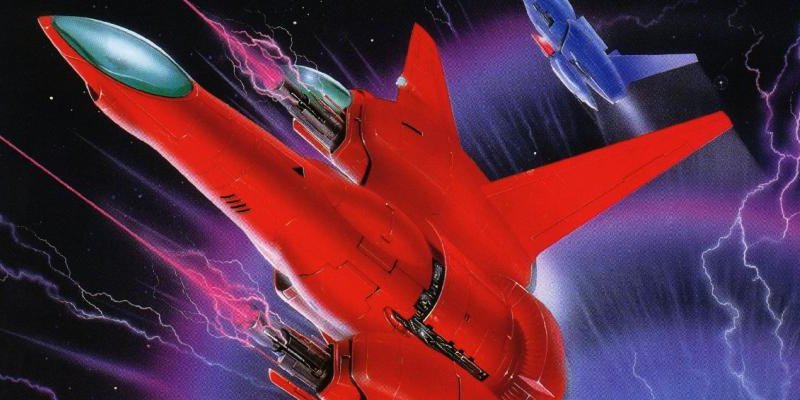
Tatsujin Ou / Truxton II (1992, Toaplan)
Tatsujin Ou was one of four shmups Toaplan worked on in 1992. Dogyuun had its unconventional weaponry, V-V sported a Gradius-like powerup system, and Fixeight was more of an overhead run-and-gun. Within this lineup, Tatsujin Ou stands alone in its straightforwardness: you get a straight shot with one of three fairly ordinary types of accessory weapon and there are only three types of item pickups in a slightly consolidated configuration of Kyukyoku Tiger's power/speed-up system. You can pick up a weapon type, a speed-up, or a bomb. Pick up a weapon of the same type you already have to power up. System-wise they were not out to try new things; the basic mechanics represent another step in the straightforward shmup lineage leading from Hishouzame all the way up to modern Cave.
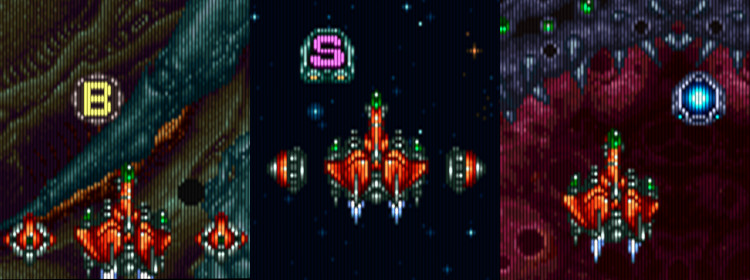
The stages are very long by STG standards -- typically 8-12 minutes each -- and the pacing is, well, let's just say deliberate. Patterned groups of small- and medium-sized enemies will repeat for long stretches in any given stage in between spots of dead air, very much adding to the impression of length. This style of level design has its detractors. They say that it's lazy copy-and-paste, or that the stages are boring in their repetition. It seems to me that this style is an exaggeration of older Toaplan titles having exciting, stressful sections punctuated by moments of calm. Tatsujin represents a good example of this design philosophy. In Tatsujin Ou, at the extreme end, you find very long, repetitive, sometimes grueling sections that demand near-perfection in between periods of sitting in one spot. Understandably, a style seemingly designed to intermittently exhaust the player has turned off many. There is a reason to want to stick around in these stages for so long, though.
In short, it's the sublime aesthetics. To start, every stage has a unique set of enemies. Each of the six stages in the game has a set of zako, midsize enemies, midbosses and a boss completely exclusive to it, with their own individual designs, graphics and attack patterns, each lovingly drawn and animated at a level not previously seen in a Toaplan shmup. Stage 2's zako will twirl impressively onto the scene with twin rocket propellers emitting smoke trails and fire homing missiles before kamekaze-ing your ship. Near the end of stage 4 you'll meet some real mean robot looking dudes that will drop giant slow-moving torpedo-things, each revealing cannons that fill the screen with shurikens. The stage 5 boss is a motherfucking giant skull with bat wings. Every enemy in this game has multiple distinct parts, and they're all big and chunky.
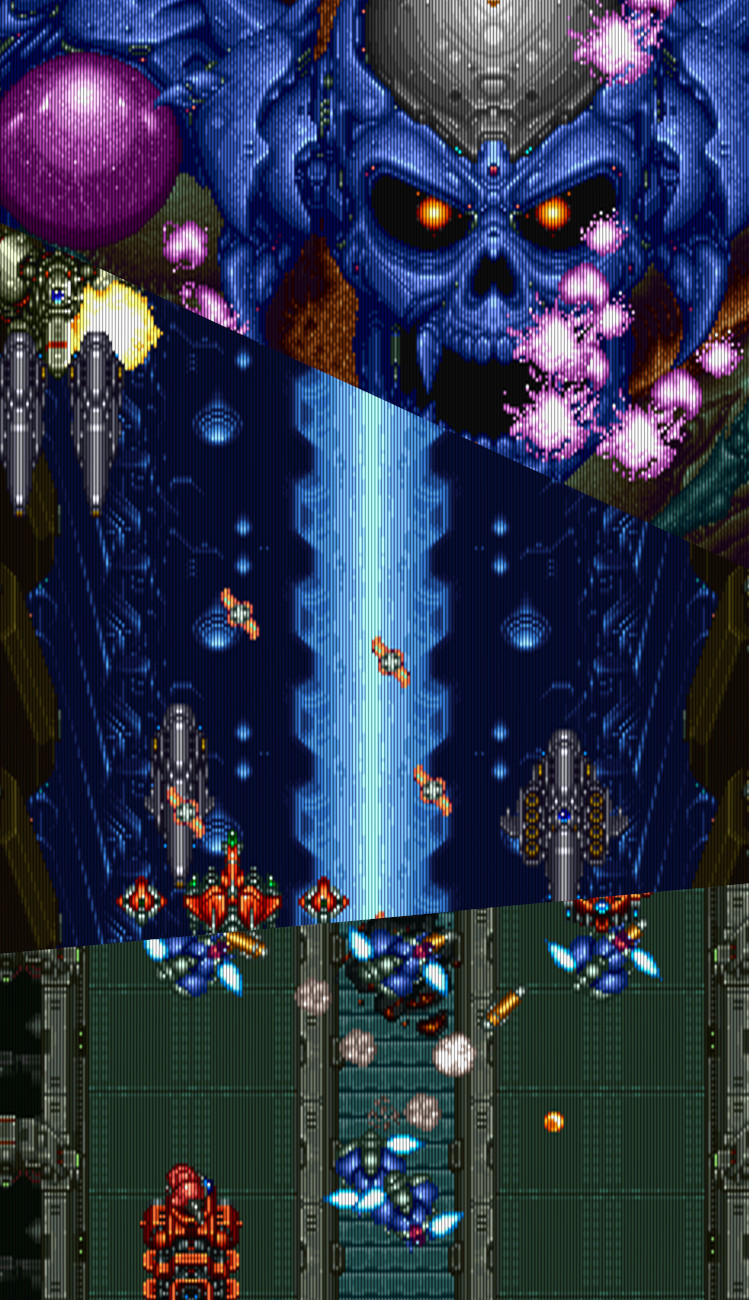
The backgrounds change several times throughout each stage, giving each section a distinct identity. In stage 1 alone, you start out in space with a beautiful parallax scrolling starfield with the occasional distant planet or galaxy, then proceed to a cratered planet surface, and then onto the enemy's base, all over roughly 8 minutes. Other shmups might have similar variety over shorter stages, but the slower pacing here means you're given more time to really soak in these environments, and evokes a sense of scale in the world that you don't get with those other, speedier shmups. Every part flows together naturally, and much like its predecessor, this game has no hard divisions between stages. Once you beat the boss, the background segues seamlessly into the next environment. The variety of backgrounds gives you the impression that you're actually playing several different stages within each stage, whereas at the same time the contiguous nature of it all evokes one long, singular journey.
Masahiro Yuge, who programmed Tatsujin, takes a back seat here in its sequel to focus exclusively on the game's sound and music. And does he ever outdo himself. The score to this game, quite honestly, is one of the greatest shmup soundtracks ever made. It takes on a mostly happy, optimistic tone, aside from the boss theme and final stage theme, and uses the hardware's newly added PCM channel for drum sounds so as to squeeze every drop of melody out of the FM synth. Stage 5's theme, Still Love You, is a standout.
So aesthetically the game is a home run. The game's graphics and music alone were enough to draw me into it time and time again to gradually dump dozens of hours into it. Unfortunately the flashy graphics occasionally come at a price. Things in Tatsujin Ou explode real good, and everything seems to have long, multiple part, big bright explosions that look pretty friggin cool. However in the developers' desire to put them front-and-center of everything else, they end up being a bit visually distracting. This may seem like a minor nitpick but much of the difficulty of the infamous beginning of stage 5 comes from the constant explosions obscuring the tiny yellow bullets' trajectories.
While we're on nitpicks, the way the item order works in this game is all jacked up. In every previous checkpoint-based Toaplan shmup, the item order resets when you respawn after a death. So in Tatsujin, for example, you're guaranteed to get a speed up item and a power up item as your first two drops, and the checkpoints were tested with these conditions. In Ou, the items are dealt out in order no matter what happens. You can even game over, start a new credit, and the item order will still be right where it left off from the last credit; you alternately start with a speed up, a power up, and in rare cases, a bomb. Some of the later checkpoints become extremely frustrating due to this, as some of them don't feel properly tested with a speed up start. Again, this sounds small, but once you start making it further and further into the last two stages in the game it really begins to grate when your chances of recovering a particularly difficult checkpoint are cut by 1/2 because trying to do it without a proper weapon means death, or at least the total depletion of all your bombs, leaving you dead on a checkpoint shortly down the line to repeat the cycle.
These particular checkpoint recoveries wouldn't be so bad with a speed up start if your default weapon didn't suck complete ass. The pea shooter is narrower than your ship and fires in a completely straight line, and it's locked to 12hz no matter what. Nothing about it feels good. It has no range and does no damage, and flies in the face of Tatsujin's absolutely perfect starting weapon with its slightly fanned out 3-way spread. What's worse, is that for all but perhaps 2 short situations in the entire game, you'll be using exactly one of the game's three accessory weapons, the red napalm. Not to say that it's a bad weapon at all, however. At full power it fires a six way spread of little volcano-like eruptions, stopping just short of the full distance of the screen in each direction, leaving behind red circles that do multiple hits of damage on whatever they touch. It is a very unique weapon that is extremely satisfying to use.
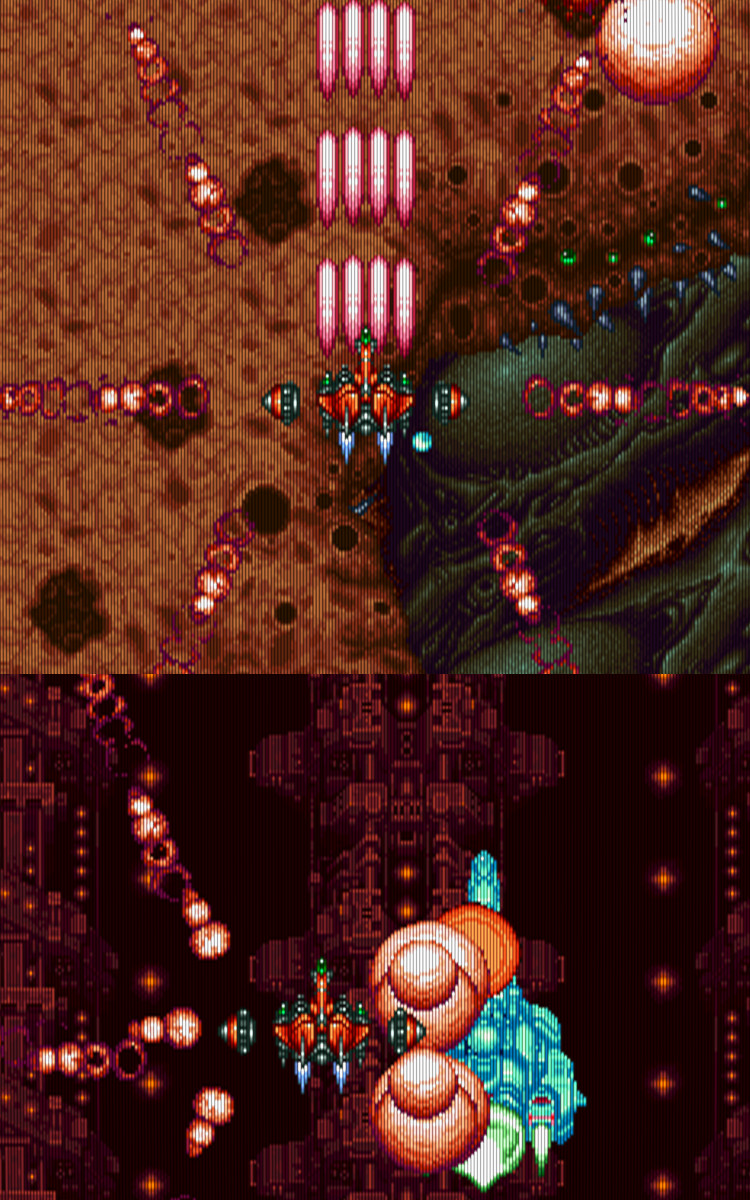
On the other hand, we have the green spread shot and the blue search laser. The green spread shot at max power will fan out to cover the screen, kind of like the blue shot from Same! Same! Same! The blue search laser will seek out enemies to focus on, much like Strawman's options from Armed Police Batrider. The problem here is that both of these weapons are far too weak to be useful in all but the most specific of situations. Green works for the zako swarms in the latter half of stage 2, and blue works for recovery in some cases, but in 95% of the game there is simply no reason not to treat these as penalty weapons because you end up gimping your damage output far too much for their practical features to come through at all.
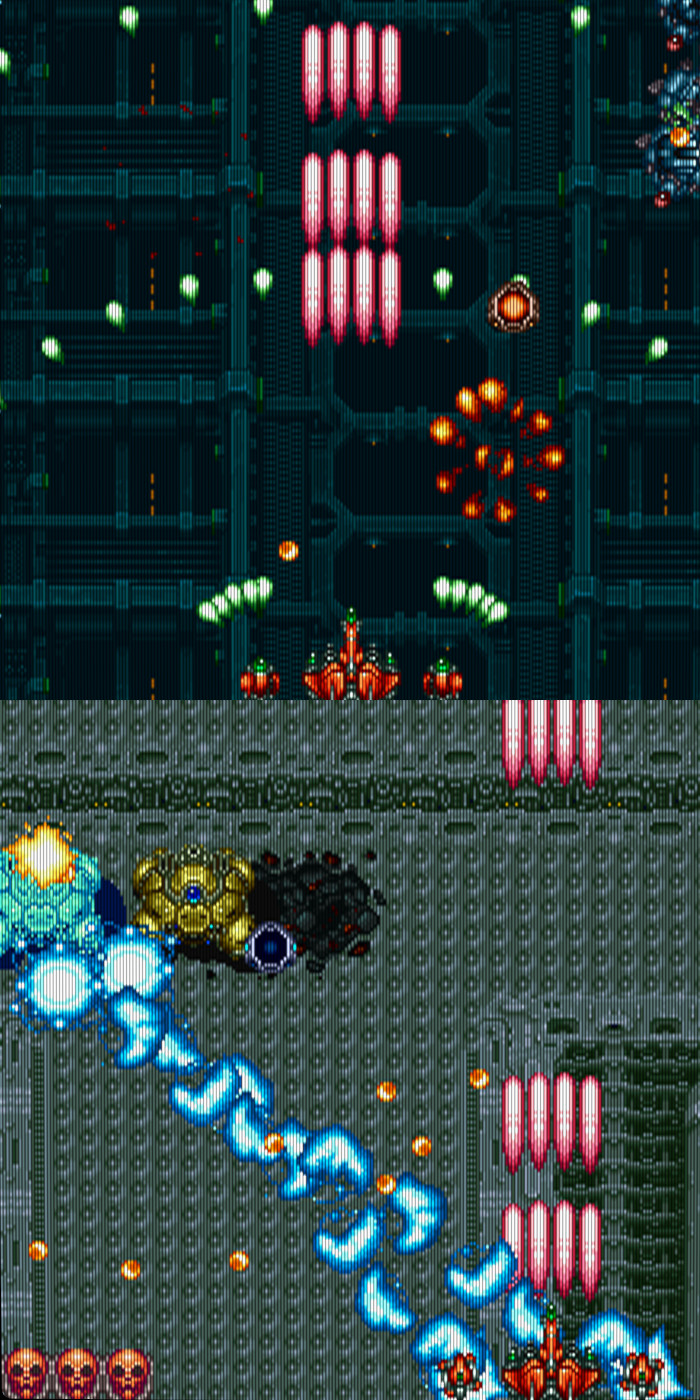
Turning momentarily back to the game's pacing. Here's where I want to say that the level design is merely an acquired taste, as it was in Tatsujin. Unfortunately the game's mellow, gradually escalating sine wave of calm and tense is sprinkled liberally with massive difficulty spikes, mostly in the form of the bosses. For example, the tame but nontrivial stage 1 ends with a boss that is somewhat of a puzzle, in that the more you damage its huge eyes, the more very hard to see bullets it will fire in addition to the attacks it normally dishes out, so the unintuitive solution is to damage it from the sides (with your napalm, natch) while avoiding his eyes entirely. You could make a case for cleverness, and perhaps we can consider it an oblique reference to Tatsujin's lightbulbs, but it seems unnecessarily cruel for literally the first boss you fight. Much worse is the stage 3 boss, where at max rank he fires so much shit your way your options are to carefully completely empty your stock of bombs or, as most serious players do, hang out in a very volatile safe spot by its side, not attacking, but carefully dancing around it until it finally decides to leave. It's unbelievably long and boring and yet your attention can't lapse for a moment otherwise something will ram into you. I find it hard to believe that this is what they originally intended.
My guess is that they wanted a really difficult boss fight that you would have to dump a few bombs on. This is fine, Tatsujin did this, bombs are a resource. The problem is that bomb drops from item carriers are an extreme rarity, even moreso than in modern Cave games where you get one bomb per stage and they basically don't want to use them ever. Every 32nd item spawned is a bomb, which, from where the item table starts when the game is powered on, means you'll get exactly 2 additional bombs before stage 5, that is, 2 bombs in roughly a half hour of play. This is a pretty far cry from the game's predecessor, where a portion of its stage 3 is more or less dedicated to maxing out your bomb stock if you're good enough. Now, this isn't an inherently bad change; they could have designed around it. However the way that every boss from stage 3 onward works tells me that they didn't, and I can only speculate that perhaps the bomb drops were more generous in a previous version of the game.
The impetus for this speculation is some remarks about a location test version of the game from this Japanese Wiki page. Roughly Google translated:
Initially, this work was not so difficult. However, after the players who played this work in the location test stated a line to the effect that "this simple game will not be accepted as a sequel to TATSUJIN", the developer has greatly increased the difficulty level ...
Another remark by Tatsuya Uemura of Toaplan, though unrelated to this game, seems to support the idea (from Shmuplations):
Actually, we wanted to make our vertical shooters easier too, so we'd initially make them quite easy for our location tests, but then someone would 1CC them in one day and we'd end up dramatically raising the difficulty level.
Tatsujin Ou is a pretty late example of the infinitely looping game with a pure survival-based scoring system. In this type of game, scoring consists almost entirely in how long you can make the credit last, so while the casuals can get their basic one loop clear and move on, the hardcore player who really loves the game will just keep going until the game or the arcade stops them. This style eventually went extinct simply due to players getting too good at the games, being able to marathon them in the game center from open to close shortly after release, which from such a machine makes the game center operator precisely 100 yen per day. Not good for business.
So how do you appease both arcade owners and the hardcore players who want to push the game as far as it can go? Well, you can do as Cave, Raizing or Takumi would eventually do and make your games finite, having a first and maybe a second round with a True Last Boss, and then overlay a deep, complex scoring system like chaining or medal collecting on top of it that can be optimized for years. This way, the casuals can ignore the scoring system, get the first loop clear and move on, and then the hardcore can go for the 2-ALL and/or higher and higher scores. Here you can cater to everyone while making sure even the greatest player's credit doesn't last longer than around an hour.
Tatsujin Ou's solution, on the other hand, was to make the first loop really fuckin' hard and then every subsequent loop even fuckin' harder. According to the previously linked Wiki, it took a month for anyone to clear Ou's first loop, which is quite a long time considering just how skilled the best Japanese shmup players are. It took a year for anyone to do two loops. Even crazier, no one was able to hit 10,000,000 points (the generally accepted stopping point for this game as it takes over 6 hours to get) for eight years. So yeah, no one was marathoning this game right at release. The downside to the approach of just making your game insanely hard from the jump though is that it effectively locks novices out of playing the game and having any kind of satisfying experience.
Loop 2 wants you dead.
The international version, titled Truxton II, fares a little better in terms of difficulty. The criticisms I've made thus far all stand, but the aggressiveness of the enemies and bosses is a little toned down, and your weaponry is a little beefed up. Overall the first half of the game becomes more pleasant (or more boring depending on your perspective), while the second half of the game remains an extreme challenge, filled with enemies that are mad as hell and don't go down quickly under any circumstances. I highly recommend starting with this version.
I want to emphasize that this game looks and sounds incredible, and that even though the lack of variety in viable weaponry is a bummer, zipping around the screen painting everything with napalm in all directions is still fun as shit and very few other shmups offer that kind of experience. All the legitimately tense setups in this game have me on the edge of my seat the whole time and are a lot of fun to pull off, no matter how many times I go through them. I belabor Tatsujin Ou's shortcomings out of love. This could have been a perfect sequel. The elements are all there, they're just configured wrong. All it needs is some relatively simple tweaks to some values; a romhack could fix this game. Truxton II alleviates some of the sting of the unbalancedness, but unbalanced it remains; still marred by bosses designed for resources you don't have, frustratingly weak weaponry and a handful of really unfair feeling checkpoint recoveries. As it stands, the game is an A+, but only if you can choke down its many mechanical shortcomings and oversights.
Final rating: 4/5 (Good)